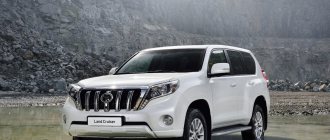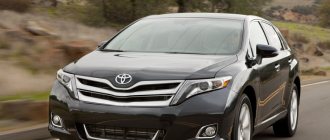Toyota Fortuner reviews
This is the page for the most recent comments about Toyota Fortuner on our website. Opinions of our readers and reviews of real car owners about the disadvantages and shortcomings of a used car of the 1st generation, as well as the 2nd generation in a new body 2015, 2021, and an updated version of the SUV, which finally appeared in Russia in 2021, 2021, 2019. Operation, engine operation, diesel and gasoline, 2.7, manual and automatic, the whole truth about fuel consumption. Comparison of Toyota Fortuner with competitors in its class and price category. The latest reviews about the car are published at the top.
Our review articles about Toyota Fortuner of various modifications, 2014 , 2016 , and the model in Russia from 2021.
Valery Hello everyone. I have been using Fortuner since May 2011, bought it from scratch in the Emirates, mileage is 140,000 km. I don’t know how it is now on the new ones, but I always have the front connected, only the front and rear are different in percentage terms and there is a lock that is rigidly connected with a 50 to 50 lever. There are no complaints or complaints about the ride quality, whether on ice or off-road. The main thing is without fanaticism. Something like that. January 25, 2019
Victor I have been using Mitsubishi Pajero Sport (2011 onwards) for 7 years on a poker, I am looking at Pradik or Fortuner. I am outraged by the inflexible position of the Japanese, who offer a couple of versions without allowing you to choose the necessary functions for yourself. The Pradika is not available on a diesel engine with a manual transmission, but the Fortuner with a manual transmission will probably come in a minimal configuration, but it will have a third row as an “appendage”!? January 16, 2018
Georgy For half a year, driving a rear wheel drive on a snowy road is murder. For winter Pradik, Padzherik, Pajero Sport, and better yet Grand Cherokee. January 13, 2018
Vyacheslav The car is beautiful and in principle and technically not bad. Part time is a matter of taste. The price is frankly too high, but the main disadvantage is the place of production - Thailand. I don’t want to say that the Thais grow their hands from the wrong place. The downside is that the car will rust quickly! Just look at the condition of the pickup trucks we sell - Ford Ranger, Mazda VT50 and even the same Toyota Hilux. December 10, 2017
Rustam Is it possible to refuse the third row of seats? December 1, 2017
Evgeniy If it weren’t for the part-time drive, I would have bought this car, but otherwise you can’t drive a Fortuner with all-wheel drive all the time, especially in the city in the summer, due to the design of the drive (there is no cross-axle differential). And with all-wheel drive disabled, it turns into a heavy frame rear-wheel drive station wagon. It turns out that all-wheel drive, in fact, should only work off-road. If you live in impassable mud, this is a good option, but too expensive. And in the city there is no competition both in quality and in price - the Mitsubishi Pajero Sport (full-time drive, price for the maximum speed with discounts of 2.4-2.5 million), whose all-wheel drive works well in the city. Toyota didn’t think through the drive – which is a pity, that is. For the village, Fortuner is too ambitious and expensive, and for the city it is not needed (due to part-time). For whom, then, was it made? October 19, 2017
Yuri Misha, where are you going to go on part-time, as you want? I don't think there is a center differential. I would like to see you connect it when you are on the go in winter on variable surfaces (asphalt - snow). These cars will not compete with each other, because whatever you say, the Fortuner will be poorer both in terms of equipment and finishing than the Prado. If we proceed from the preliminary prices and compare the Fortuner at maximum speed, then it is better to add a little (so 200 thousand) and take the Prado, though without locking the rear differential because where there is a blocking, there is a different price (about 3.5 million rubles) and a capricious KDSS system. The repair of which will cost the officials about 300 thousand hazel grouse (data from the article “We counted and shed tears.”) The mileage before replacement is also indicated as 60-80 thousand, depending on your luck, and after 100 thousand the replacement is clear. So figure out what's what. Either put up with part-time and poor equipment, or with the lack of rear differential locking. It depends on you, but the lack of blocking for 7-8 years has never bothered me, lowering it was enough. Toyota's problem is different: even if you want a rear differential lock or simple heated rear seats in your configuration, they will deny you this. That is, you cannot choose the options that suit you. Well, here you either leave the guarantee and go to collective farming (if you find smart mechanics), or accept it. It suits whoever. October 6, 2017
Misha Fortuner is cheaper than Pradika. The frame is new, Park Time, which you can ride however you want. It will not be easy for Pradik to compete with the new Toyota Fortuner. October 3, 2017
MICHAEL Everyone is talking about competition with the Prado, but the Prado has permanent all-wheel drive, and here it’s part-time, like on a UAZ. On public roads only with rear-wheel drive, and the front end is rigidly connected when off-road. September 28, 2017
Alex U Prado will not take away clients. Prado is from the Land Cruiser line and is a prestigious car. And the Fortuner is a converted truck, it will be a workhorse and a car for hunting and fishing for the rich. It’s like the Koreans are puffing themselves up with their Genesis, but still they won’t be on equal terms with Mercedes. There are traditions... legends... September 27, 2017
more reviews
Review of Toyota Fortuner 2.7 4WD (2008)
So Pajero left me to serve another owner, blinking his orange turn signal goodbye. But since it was exchanged for real estate, which still needs to be sold well, we still have to wait for money for another car. Therefore, the problem of a temporary car arises in full force. Fortunately, the world is not without good people, and a good friend of mine, leaving for a long business trip abroad, left his Toyota Fortuner for use. Fortune really smiled. So unexpectedly this long test drive happened.
And although they don’t look down the barrel of a donated tank, my review will probably not be completely laudatory. If you do not take into account the shortcomings associated with operation - the seats, apparently burned by cigarettes, and the front brake discs, which is why the car brakes unevenly, then overall the car makes an indefinite impression. The appearance is such that there is nothing to catch your eye on; your eyes will glide over the body and you won’t remember anything. Such a correct full face and profile, but it cannot be called beautiful. Railings would be nice and would brighten up the slightly flattened roof. Because of this roof, you sit in this car, stretching your legs forward, and even bending at the waist more than you would like. The high floor also contributes to this. In general, I was never able to get comfortable behind the wheel, despite all the adjustments. All the same, the genes of the ancestor - the Hilux pickup truck - make themselves felt.
By the way, this relationship with a pickup truck had an unimportant effect on the interior. I personally don’t care what kind of plastic is in the cabin, I try to touch it less. But the Spartan origin is also expressed in the absence of many useful things that you expect from such a car, as if by default - an indicator of outside temperature, fuel consumption, power reserve, all sorts of compasses, altimeters and inclinometers. I'm not even talking about ABS and folding mirrors, all kinds of heating. In general, there is none of this, but there are wood-like plastic inserts on the side air deflectors. Coupled with the aluminum-look plastic on the center console, the entire interior makes a depressing impression.
Well, what about in motion? In the city, the Fortuner is clumsy, the weak 2.7-liter engine initially seems to pull well, but quickly turns sour and acceleration turns into flour. For some reason, the box does not react in any way to a sharp press of the gas pedal, it lives its own life. By forcibly increasing the speed by limiting the top gear with the lever, you can achieve some improvement, but not by much.
The situation outside the city is better, although sudden overtaking is also not recommended, it still won’t work. But you can accelerate and have fun rolling along a smooth country road. The frame jeep really doesn’t like uneven surfaces; it jumps on them, rushes about and sweeps its tail. You have to constantly drive the car, which makes you very tired. The maximum speed is indicated as 180 km per hour, but after 130 it somehow becomes very scary.
But it is not all that bad. On the way to the dacha there is a section of a country road, about 10 kilometers. All my previous cars passed through it. On this section, the Pajero shook like a leaf, the Prado involuntarily fell from side to side, and the GX 460 wagged its tail like young people at a disco. So, Fortuner won an unconditional victory in this exercise - he completed it simply and easily, at high speed and without problems. It was simply amazing, he simply floated over the potholes, apparently the suspension simply did not have time to work out all the irregularities. It was Fortuner’s element, he was number one there.
The undoubted advantages of the car also include unpretentiousness, ease of maintenance, and a friendly character common to all Toyotas. The 2.7 engine is very economical and undemanding on gasoline. This is not very noticeable, but a very useful and versatile assistant. You can take a large group out for a picnic, or you can drag sacks of potatoes from the village to the city. An all-weather soldier of fortune, a simple hard worker who can be forgiven for some shortcomings for his willingness to always lend a helping hand.
Toyota Fortuner 2017-2018: reviews from real owners
“I first saw the new Toyota Fortuner and was able to drive it in the spring of 2021, when sales in Russia had not yet begun: my wife and I were vacationing in Thailand, where one of the friendly local residents in broken English was happy to talk to us and at the same time give us a ride on the street.
Upon returning home, I immediately went online in the hope of reading reviews from the first owners, but discovered that there were simply none, since the car was not for sale here. The next day I went to the salon to talk with the managers, but they said that there was no information yet. Of course, I was upset because I liked the car, and then in August I accidentally came across the news that the first deliveries would begin closer to October. I immediately called the dealership where I had gone a few months earlier: they confirmed that official sales would indeed begin in Russia, but it was unlikely that I would be able to get the car before November. We were a little saddened by the fact that it will only be possible to purchase a diesel engine, but I would prefer the gasoline version.
I left a pre-order for the “Elegance” package in white: firstly , it costs less, and secondly , I just don’t like dark tones. And then in the second half of November the manager called and invited me to come pick up the car. Immediately in the cabin I purchased additional crankcase protection, Webasto and an alarm system.
I had no experience driving a car with a diesel engine before. During the trip home, the first thing I noticed was a slight vibration at idle, radiating into the steering wheel. I was pleased with the high seating position and, as a result, excellent visibility.
The dealership said that for the first 1000 km it is better not to drive faster than 100 km/h. At the moment, I have already driven 6,000 km: I can say with confidence that a diesel engine is no worse than a gasoline engine. There are some nuances: for example, it’s better not to, so Webasto came in handy.
Among the advantages I can note the following:
- good optics (illuminates the road well for both low and high beam);
- light sensor – I was previously unfamiliar with this function. In principle, it’s not a very necessary thing, but it’s quite convenient, so let it be;
- comfortable seats (one day I drove about 500 km - my back didn’t stiffen, I wasn’t tired at all);
- heated steering wheel is a useful option, especially in winter;
- plenty of free space between the first and second rows of seats;
- voluminous trunk.
But there are also disadvantages (fortunately, very few):
- there is no headlight washer (it’s strange, of course, that they couldn’t supply it for such a price);
- poor placement of the right armrest, as a result of which the arm hangs in the air if you lean on it;
- no navigation program.
Summarizing all of the above, I want to say that the car is really good! Of course, there will always be people who will say that for that kind of money you can find something better, but I don’t regret the choice I made.”











